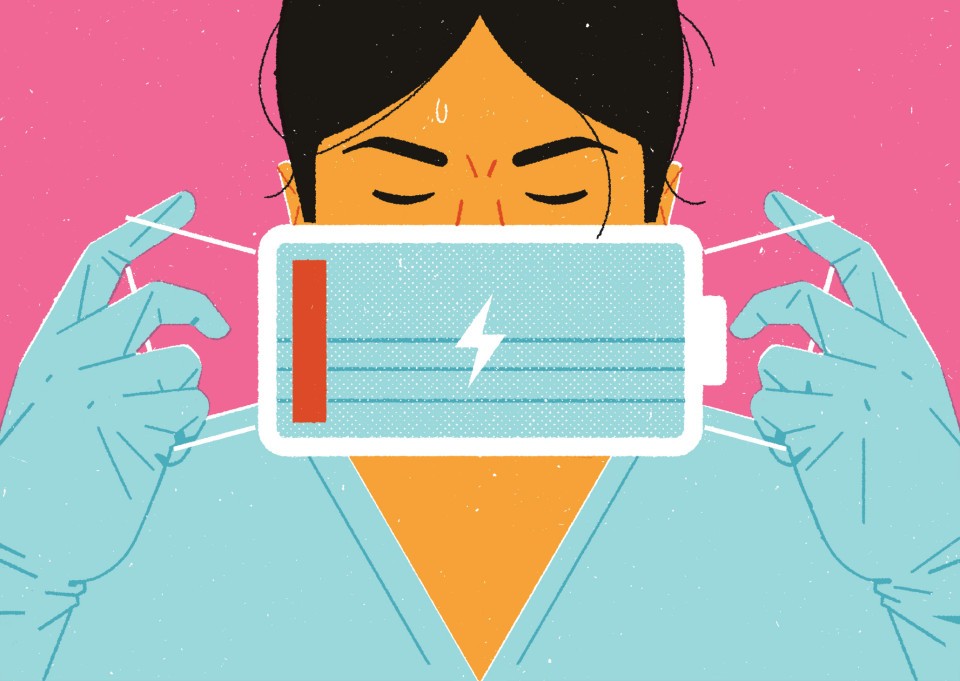Where Have All the Nurses Gone?
Stress, exhaustion, strikes, turnover — the nursing field has been through the wringer. Something needs to change.

The nursing shortage is dire. / Illustration by Matt Harrison Clough
In February 2021, a news story broke about a deadly interstate pileup involving 100-plus vehicles in Fort Worth, Texas. A main focus of the story: One of the drivers involved, Rebecca Benson, crawled out of the wreckage unscathed — despite having crashed into two semitrucks and being pinned by other cars — and hitched a ride with a co-worker to make her shift as a nurse at Cook Children’s Medical Center. It wasn’t until hours later that she agreed to be seen by a doctor in case she’d been injured.
It’s true that we all process trauma differently. Some of us keep busy; others resume our everyday routines. Some retreat to a quiet bedroom or place of worship, while others seek healing in a therapist’s office. Sure, Benson might have processed that distressing collision by caring for patients — she admitted in an interview that she felt compelled to get to work to help others and avoid reliving the moment. But her decision was a harbinger of a larger issue: Many people in caregiving positions are conditioned to feel as though they must treat others before caring for themselves. They’re not only (rightly) praised for doing so; they’re expected to, as if their mental and emotional well-being must come second to everyone else’s. This is a direct result of a labor system, particularly in the United States, that prioritizes production above all else — that says work is more important than personal health.
For nurses especially, this sentiment has become acute. Their frontline role has historically involved high stress and turnover due to the physical and emotional tolls involved. Even before the pandemic, nurses reported feeling burned out and ready to leave their employers. According to survey data collected from December 2019 through February 2020 and analyzed by Penn researchers, more than 40 percent of 33,462 registered nurses (RNs) reported high burnout; one in five planned to leave their employer within one year, and 56 percent noted that understaffing caused challenges in their workplace. All of this creates a domino effect. “Retention of experienced nursing staff is challenging, and ICUs in particular have a very high rate of turnover,” says Mike Pizzi, a 12-year RN currently working at Children’s Hospital of Philadelphia. “This puts a lot of pressure on nurses to train new staff, which in turn leads to even more burnout.”
COVID, of course, exacerbated these issues. “When the world ‘stopped,’ health care did not,” says Brianna Williamson, an RN who started her nursing career in November 2020 offering COVID testing with Northstar Health and now works in the operating room at Pennsylvania Hospital. The world leaned on frontline workers — our lives literally depended on them — and yet they’re not always treated as the heroes we consider them to be. Since the start of the pandemic, there have been increases in nurses’ stress and exhaustion levels, in verbal abuse RNs suffer from patients and/or their families, and in workplace violence — like the case of the Jefferson University Hospital nursing assistant who shot and killed his co-worker in 2021.
Nurses have been frustrated and fed up for a while now, and it seems the pandemic brought a breaking point. Many throughout the country — including more than 12,000 RNs across seven New York hospitals — have gone on strike over the past year, demanding that health-care settings hire more nurses and introduce fixed nurse-to-patient ratios in order to manage patient safety and nurse workload. This past October, Temple University Hospital’s nurses and technicians authorized their unions to submit a strike notice to administration. That strike was averted with a new contract guaranteeing higher pay, reduced mandatory overtime, and improved protocols for safety.
Many, many other RNs have called it quits — and those who haven’t yet likely will. A November 2021 McKinsey study revealed that 32 percent of RNs in the U.S. were “highly” considering leaving their direct patient-care roles, with 20 percent saying they’re planning to exit the field completely. Though those numbers have decreased per a survey conducted in January by the American Nurses Foundation, an aging population will complicate things. Because baby boomers make up approximately 55 percent of the current RN workforce, some observers predict the field will see more than a million nurses retire within the next 10 to 15 years. Oh yeah — and by 2030, all the baby boomers will be at least 65 years old, meaning even more need for geriatric patient care.
And the infrastructure isn’t sound. According to the most recent report by the American Association of Colleges of Nursing, nursing schools across the U.S. turned away nearly 92,000 qualified applicants from their programs in 2021 due to “insufficient number of faculty, clinical sites, classroom space, and clinical preceptors, as well as budget constraints.”
Despite these major deterrents, people are still interested in becoming — and remaining — nurses. Both Williamson and Georgie Sipala, a 12-year RN who works in maternal fetal medicine at the Hospital of the University of Pennsylvania, say caring for patients keeps them in the field. (“I’ve spent my entire career in women’s health and feel fulfilled knowing that I make a difference,” Sipala explains.) For Chuck Prendergast, an RN in Jefferson University Hospital’s medical ICU, it’s his co-workers: “The people I work with and the camaraderie we share is the best part of my job. We’ve even planned cruises together! Being part of my team has reminded me for nearly a decade that to be a nurse, you have to be caring, compassionate and dependable — to your patients, of course, but to your colleagues, too.”
Then there’s East Kensington resident Nick Bailey, who left a job in brand strategy to enroll in nursing school. “While my job was challenging and interesting, I didn’t find the work to be particularly fulfilling,” he says. “Nursing seemed like the right fit for me, because not only do nurses care directly for patients; there are so many different career pathways — from bedside nursing to advanced-practice nursing and anesthesia.”
Local health systems are helping to amplify those pathways for future nurses — and their retention, too. Last year, Penn Nursing landed a $125 million gift to establish the Leonard A. Lauder Community Care Nurse Practitioner Program, which provides tuition-free support to students studying to be primary-care providers and wanting to work in underserved communities. Chaudron Carter Short, Temple University’s Department of Nursing chair and Temple Health’s senior vice president and associate chief nursing officer, says Temple recently changed its curriculum to get students into clinical settings earlier — with sophomores able to work as nursing assistants, juniors in externships, and seniors in a year-long nursing residency program — for a smoother and stronger transition into the field.
Penn Medicine’s new ASPIRE program — a partnership with La Salle University and educational scholarship organization the Howley Foundation that launched this past January — will essentially funnel Philly high-school juniors into nursing school. Every year, up to 25 students will participate in an enrichment program that will last through graduation and provide exposure to hands-on skills, clinical observations, and mentorship. Students then can pursue a BSN at La Salle with the support of federal grants and program scholarships as well as apply for part-time employment at HUP. Beth Smith, corporate director of nursing professional development at HUP, says the inaugural application period saw more than 150 interested candidates from more than 30 Philadelphia high schools, signaling a “high level of interest in and need for a program like this.”
It’s hard to say what the future of nursing will look like. Reports have predicted that the workforce will grow by between six to nine percent over the next decade, and that there will be job openings for RNs every year through 2031. But both those glimmers of hope are tempered by the prospect of losing nurses in droves to retirement or voluntary exits — just as the need for direct patient care skyrockets.
All the Philly-area RNs I spoke with have mixed emotions about the future. They’re hopeful that the field is changing for the better, but they also recognize that their profession faces a long, hard road. “It seems that since the pandemic, the general public has a better understanding of what nurses actually do, whether from personal experiences or the media,” says Sipala. “The newfound knowledge and ‘praise’ bring much-deserved recognition and respect to the profession as a whole. On the flip side, the pandemic has seen many nurses leaving the bedside, which causes staffing shortages and affects the quality of care nurses can provide.”
For Bailey, the field’s myriad possibilities have been a big motivator during nursing school — he’s scheduled to graduate in August 2024. But he told me he’s unsettled by what’s seemingly out of nurses’ control: “I’m frightened by the continued instability of our national health-care and social support systems. Patients get sicker when they aren’t able to afford medications or preventative procedures and when they don’t have access to food or affordable housing, meaning current challenges will only continue to compound.”
That’s a fair concern. The nursing sector sees obstacles that can be attributed to policies at nearly all levels — federal, state and institutional — and that limit the ability of nurses to practice to the full scope of their education and license, according to Antonia Villarruel, the Margaret Bond Simon Dean of Nursing at Penn’s School of Nursing and director of Penn’s WHO Collaborating Center for Nursing and Midwifery Leadership. For instance, nurse practitioners in Pennsylvania must have two collaborative agreements with a licensed physician to practice and write prescriptions, in contrast to 26 states and the VA that allow nurse practitioners to work without supervision. “Such regulations have a direct impact on access to care for rural and other underserved communities,” Villarruel says. These, unfortunately, don’t appear to be changing anytime soon.
One thing is certain: The industry needs to be nursed back to health — and not at the expense of those wearing the scrubs.
Published as “Vital Signs” in the May 2023 issue of Philadelphia magazine.


